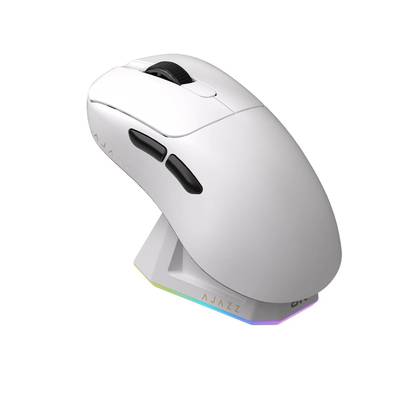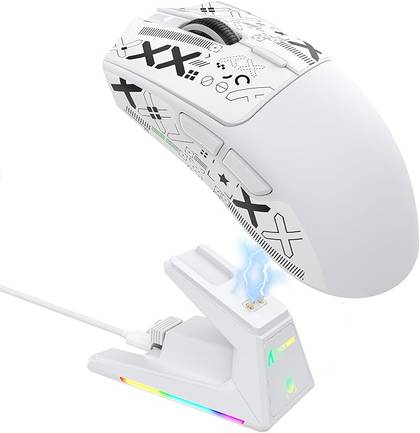Summary
- High-end performance doesn’t require big brands, as Chinese budget clones offer top specs at a fraction of the price.
- Many clones pack PixArt PAW sensors, quality switches, 8K/4K polling, PTFE skates, and wireless, all under $50.
- Simple mods like PTFE skates, switch swaps, and aluminum tape can significantly upgrade the feel and performance of cheap mice.
If you’re serious about online gaming, you’ve probably thought about upgrading your mouse. But those brand-name price tags are enough to make anyone click away. The good news? You don’t have to spend a fortune to get the same specs—you just need to find the right budget model.
Cheap Mice Have Come a Long Way
There used to be a time not long ago when, if you wanted a reliable ultralight gaming mouse, you had to choose a model from well-known brands like Logitech, Razer, or ASUS. Their mice are known for sturdy build quality despite a low weight, highly accurate sensors with zero acceleration, low-latency wireless, optical switches, and features like an infinite scroll wheel or multiple programmable buttons.
The main drawback of these brand-name mice is their price. Even if all you want is a basic, dependable lightweight mouse for first-person shooters, you still have to spend anywhere from $100 to $200 on something like the Logitech G Pro X Superlight 2 or the Razer DeathAdder V4 Pro.
Even niche brands geared toward competitive esports players, such as Pulsar, Lamzu, and Zowie (BenQ), sell performance mice in the same price range. Models like the Lamzu Maya X and Zowie EC2-DW are excellent alternatives if you want to try different shapes without sacrificing tracking accuracy or responsiveness, but they’re not exactly budget-friendly.
While these mice are top-of-the-line and come with the best in every aspect (including software and warranty), you can get much of that same quality while spending less than a third of your hard-earned cash. To get the best bang for your buck, you can go with a budget gaming mouse from China.
Popular brands include Zaopin, Ajazz, Attack Shark, Royal Kludge, Mchose, Scyrox, and ATK (some of these seem related, as they use virtually identical websites). You can often find these mice on Amazon, Walmart, AliExpress, eBay, and other online storefronts. Do some comparison shopping to find the most affordable option, as prices can vary significantly.
Many of their products are clones of popular esports mice, but the cool thing is that they use high-end components that match or even surpass the brand-name models.
For starters, you’ll commonly see the PixArt PAW 3950 or the slightly older PAW 3395 sensor in these mice. These are the industry standard among high-end mice that don’t use proprietary sensors like Logitech’s HERO or Razer’s Focus Pro, so you know you’re getting extremely accurate tracking and a low LOD (lift-off distance).
Aside from the sensor, you’re also getting light and durable construction, Bluetooth, and 2.4GHz wireless connectivity with polling rates of up to 8K, PTFE mouse skates, and high-quality scroll wheel encoders. Some models even include gimmicky features like charging bases that can display GIFs, which is a nice touch.
Another feature common in budget mice is quality mechanical or optical switches from established brands like TTC, Huano, and Kailh. Depending on who you ask, they’re often superior in feel and reliability to the Omron switches found in brand-name mice. I personally replaced the Omron switches in my Logitech G502 with Huano switches, and the difference was night and day.
The Best Gaming Mice Under $50
At the time of writing, these models can be found for under $50, so prices may change. In fact, many are under $40, and some even fall below $30, depending on the site. To find the best deals, be sure to check all of your favorite online sellers.
Let’s start with the mouse I’d wholeheartedly recommend to most gamers in a heartbeat—my Ajazz AJ179 Pro. It’s a Vaxee Outset AX/Lamzu Thorn clone with durable construction and a weight of around 58g, a PAW3395 sensor, Huano Transparent Green Shell White Dot switches, 8K polling rate, a magnetic charging base that doubles as the 2.4GHz receiver, Bluetooth, and a fairly standard F-switch scroll wheel encoder.
The only thing you really need to upgrade is the mouse skates (which is true for many mice), as the black ones that come with the mouse drag a lot. Like other Ajazz mice, there are a couple of cheaper alternatives with slightly lower specs—the AJ179 and AJ179P—along with the top model in the lineup, the AJ179 Apex. The Apex has a PAW 3950 sensor, which is ever so slightly better and has a lower LOD, though most people are unlikely to notice the difference.

- Wireless?
-
Yes
- Connectivity
-
Bluetooth/2.4G/USB Type-C
The Ajazz AJ179 Pro is an affordable ultralight gaming mouse, weighing just 58g. It features the precise PAW3395 sensor, supports an 8K polling rate via its 2.4GHz charging base, and also offers Bluetooth connectivity.
A mouse with almost identical specs but 2g lighter is the Ajazz AJ159 Pro. It’s significantly slimmer, though, as it’s a Ninjutsu Sora V2 (or actually, V1) clone.
Another popular mouse to consider is the Attack Shark X3. It’s a Logitech G Pro X Superlight clone, though it is slightly smaller and significantly lighter (49g vs. the G Pro X 2’s 60g). If you tried the Superlight and found it a bit too heavy or large for your hands, the X3 might be perfect for you. The X3 features 2.4GHz wireless and Bluetooth, a 1K polling rate, a PAW3395 sensor, Kailh GM 8.0 Black Mamba switches, an F-switch encoder, and pure PTFE skates.
In my opinion, the only thing holding the X3 back (very slightly) is the 1K polling rate, but even that won’t be an issue for most people most of the time. Strangely, the premium version of this mouse, the X3MAX, upgrades the sensor to the PAW3950 and the switches to Omron opticals but keeps the same 1K polling rate.
If you’d prefer a clone of the Razer Viper V3 Pro instead, the Attack Shark X1 is unbeatable at its sub-$40 price tag. It has very similar specs to the X3, except that it weighs 53g and uses optical Omron switches.

- Weight
-
53g
- Sensor and DPI
-
PAW3395 Pro Sensor, 40000DPI
The Attack Shark X1 is an ultralight wireless gaming mouse with a premium PAW3395 Pro sensor, tri-mode connectivity, and a magnetic RGB charging dock. It delivers fast, accurate tracking and long battery life, making it a great option for both competitive gaming and everyday use.
Lastly, if you want a DeathAdder clone but don’t want to sacrifice performance and wireless connectivity by going for the original Razer DeathAdder Essential, you should get the Attack Shark R1. It uses the older PAW3311 sensor, but at a price of under $30, it’s also one of the cheapest wireless DeathAdder clones on the market.
Not to be confused with the Attack Shark R1, the ATK VXE Dragonfly R1 Pro is another great budget-friendly ultralight mouse. ATK is a separate brand from Attack Shark and has its own range of mice, ranging from $20 to over $100, so check them out.
The R1 Pro is part of the R1 Series that ranges from around $20 to over $50, depending on the exact model. The Pro version has some nice upgrades over the cheaper models, though they’re all worth picking up. The shape is often compared to that of the Endgame Gear OP1 and the Lethal Gaming Gear LA-1, though it is a bit wider than both.
In any case, the R1 Pro has a weight of 48g, a matte ice finish, and is equipped with a PAW3395 sensor, 4K polling rate (with a separate 2.4GHz receiver), Huano Ice Berry Pink Dot switches (which I can’t find any info on), an E10 or TTC Silver encoder, and white PTFE skates.
Remember, this is just the tip of the iceberg when it comes to cloning mice. I only had space to highlight some of my favorite options, so don’t be afraid to explore some other offerings on the market.
You can use EloShapes to compare shapes and specifications to find clones of your favorite mice.
You Can Always Upgrade a Cheap Mouse With Mods
If you bought a Chinese clone mouse based on its shape and sensor, that’s a great start. It’s hard to find the perfect mouse, but with just a couple of simple mods and a few extra bucks, you can tune it to your liking.
When I got the Ajazz AJ179 Pro, one of the first things I did was replace the black mouse skates with virgin PTFE (white) ones for a smoother glide. I had to do the same on my $150 Logitech G502 Lightspeed as well, so it’s not like this is something the name brands get right every time (though most of them have now switched to white skates).
An upgrade that takes a bit more time and some soldering know-how, but is totally worth it, is upgrading the mouse switches. While many of these Chinese mice come with decent switches out of the box, you might find that you prefer the sound, tactile feedback, and feel of another switch. I wasn’t a fan of the Huano Transparent Green Shell White Dot switches used in my Ajazz AJ179 Pro, which is why I replaced them with TTC Golds.
Another easy mod that can improve any mouse (and something you might have to do on expensive mice, too) is the aluminum tape mod. This involves placing a few layers of thin aluminum tape underneath the left and right button plungers to minimize pre-travel, which makes the clicks feel more responsive. After I modded my Ajazz mouse, the clicks felt even more responsive than my G502, so I had to open up the G502 and mod it as well!
I’m not trying to dissuade you from buying a high-end premium mouse from established brands. If you like them and are willing to spend the money, by all means, go for it! But if you want the same raw performance at a fraction of the cost, you should know that you can be competitive with these budget-friendly clones. Just make sure to pick the one that fits you best!








